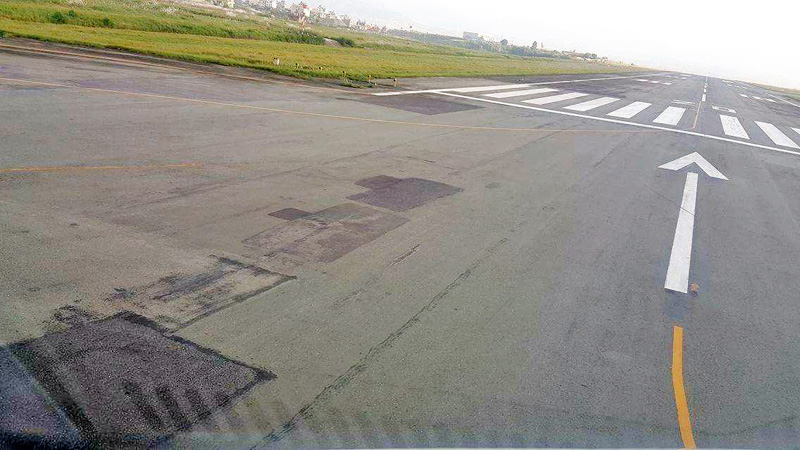Airbus tyre burst raises safety concerns at pathetic TIA
KATHMANDU: Runway surface conditions at the Tribhuvan International Airport, especially surface unevenness and unremoved rubber deposits, are now beginning to take a toll on Nepali aircraft and their landing gears-wheels, as can be viewed from the recent events including the one involving Nepal Airlines Airbus 320 jet.

According to pilots, the NAC jets, with their operations base at TIA, typically make three to four landings at TIA daily and their landing gears, mainly wheels, are subjected to regular torture by the ill-maintained runway surface conditions.
“Naturally, the landing gear components will be subject to unforeseen failures, as recent events dictated,” an international airline engineer said.
In the recent past, the fact that airport operations at the TIA had to be repeatedly curtailed for carrying out pavement maintenance speaks volumes about the state of pavement surface, more pathetic than THT had recently reported of uncomfortable statistics on landing-related incidents involving international carriers in the last two years.
“The TIA runway maintenance has now become a bottomless pit, devouring financial resources without any checks in the name of continuing operations and providing incentives to the rapid action team that patches cracks or perhaps dispatches foreign object debris,” an international airline pilot commented while talking to THT Online.
Admitting that the uneven surface condition increased the safety risks, TIA’s spokesperson Prem Nath Thakur said, “Different teams have been conducting regular inspections on the runway surface while a team of experts from India will start removing the rubber deposits in a day or two.”
The latest safety directive by the Civil Aviation Authority of Nepal prohibiting the use of Michelin aircraft tyres are clearly a distraction as researches show that there appear to be no current airworthiness directives for A320 Michelin tires anywhere across the globe.
“Aircraft tyres are expensive and retreading is a frequent norm worldwide,” an airworthiness engineer claimed.
Besides, the facilities where tyre retreading is done are formally CAAN-approved organisations, vetted by CAAN airworthiness inspectors after a detailed audit.
“Unless the tyres were sourced from an unauthorised source, the problems in all likelihood originate from local conditions.”
Though a regulatory safety investigation by CAAN was clearly warranted in such cases, the Ministry of Culture, Tourism and Civil Aviation has strangely overstepped its jurisdiction and constituted an investigation commission into this issue with a glaring conflict of interest again, a senior CAAN director reacted.
The member-secretary of the probe commission is a regular CAAN staff, whereas the chairman heads the CAAN supervision division at the Ministry.
“Any likely finger pointing at TIA-CAAN’s "complicity" is therefore clearly off the table, whereas any blame at NAC’s management as well as engineering incompetence will draw fire to the chairman’s earlier role in
approving the NAC’s airbus fleet expansion.”
Besides, drawing engineering expertise for the investigation from a rival Nepali airline is also sure to raise eyebrows, a MoCTCA official cautioned.
“The investigators would like to visit the Michelin factory abroad for the tire forensic investigation, as is other junkets.”






